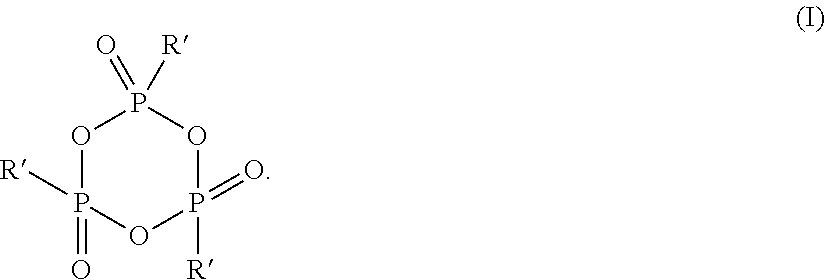Process for preparing nitriles by elimination reactions
a technology of elimination reaction and nitrile, which is applied in the preparation of carboxylic acid nitrile, organic compound preparation, carboxylic acid nitrile, etc., can solve the problems of difficult separation from the product, restricted significance of modern organic synthesis, and no longer possible unselective methods, etc., to achieve easy water-soluble and easy phase separation
- Summary
- Abstract
- Description
- Claims
- Application Information
AI Technical Summary
Benefits of technology
Problems solved by technology
Method used
Image
Examples
example 1
Benzonitrile from Benzoic Acid
[0024]1 mol of benzoic acid, 1.1 mol of tert-butylamine and 2 mol of NEt3 are initially introduced into 150 ml of ethyl acetate. 1.2 mol of T3P® propanephosphonic anhydride solution in ethyl acetate (50% w / w) are metered in over the course of one hour, then the mixture is afterstirred for a further three hours at this temperature. At this time, the reaction GC indicated a conversion of 100%. The reaction mixture is heated to boiling for 3 hours and, after cooling to room temperature, 180 ml of water were added and the phases were separated. The organic phase was distilled. The isolated yield of this reaction was 96%, HPLC purity 98% (a / a).
example 2
4-Methoxybenzonitrile from N-tert-octyl-4-methoxybenzamide
[0025]1 mol of N-tert-octyl-4-methoxybenzamide and 2 mol of NEt3 are initially introduced into 150 ml of ethyl acetate. 1.2 mol of T3P® propanephosphonic anhydride solution in ethyl acetate (50% w / w) are metered in. The reaction mixture is heated to boiling for 3 hours and, after cooling to room temperature, 180 ml of water were added and the phases were separated. The organic phase was distilled. The isolated yield of this reaction was 96%, HPLC purity 98% (a / a).
example 3
Terephthalodinitrile from N-tert-octyl-4-cyanobenzamide
[0026]1 mol of N-tert-octyl-4-cyanobenzamide and 2 mol of NEt3 are initially introduced into 150 ml of ethyl acetate. 1.2 mol of T3P® propanephosphonic anhydride solution in ethyl acetate (50% w / w) are metered in. The reaction mixture is heated to boiling for 3 hours and, after cooling to room temperature, 180 ml of water were added and the phases were separated. The organic phase was distilled. The isolated yield of this reaction was 95%, HPLC purity 97% (a / a).
PUM
| Property | Measurement | Unit |
|---|---|---|
| Temperature | aaaaa | aaaaa |
| Equivalent mass | aaaaa | aaaaa |
| Equivalent mass | aaaaa | aaaaa |
Abstract
Description
Claims
Application Information
 Login to View More
Login to View More - R&D
- Intellectual Property
- Life Sciences
- Materials
- Tech Scout
- Unparalleled Data Quality
- Higher Quality Content
- 60% Fewer Hallucinations
Browse by: Latest US Patents, China's latest patents, Technical Efficacy Thesaurus, Application Domain, Technology Topic, Popular Technical Reports.
© 2025 PatSnap. All rights reserved.Legal|Privacy policy|Modern Slavery Act Transparency Statement|Sitemap|About US| Contact US: help@patsnap.com


